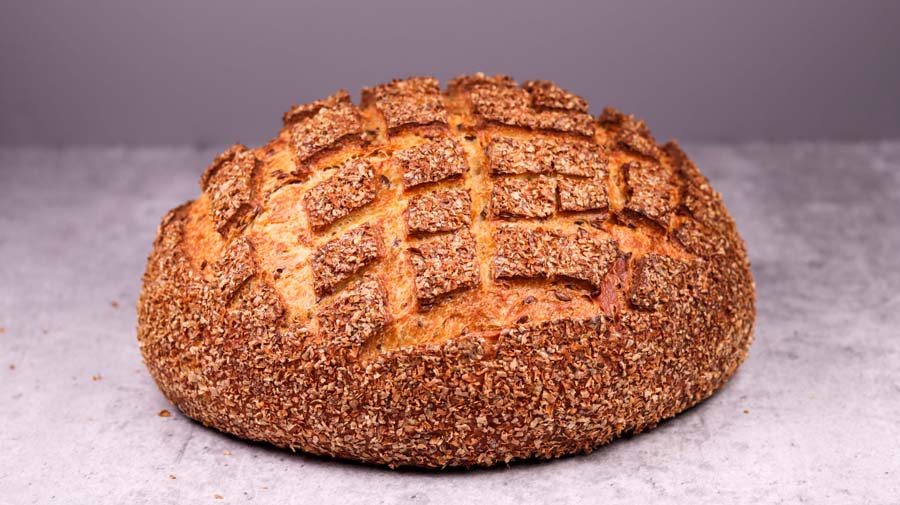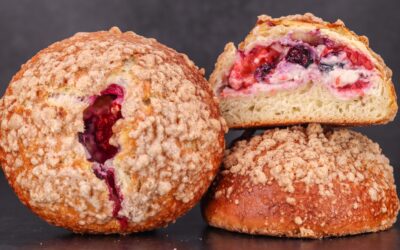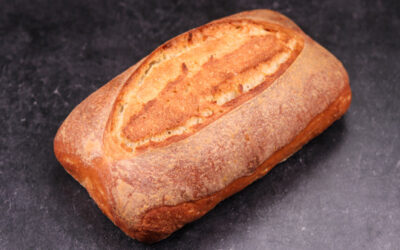I’ve previously made a video about the use of various dairy products in breadmaking like milk, yogurt, sour cream, and buttermilk. Milk being the base for the other ones has a different effect on bread dough than the products that are made from it. Adding milk to bread dough makes it looser and softer while using sour cream, yogurt, or buttermilk makes the dough tighter.
The tightening effect is caused by acidity. Fermented dairy products have a lower pH than milk or water. Knowing this we can use it to our advantage. Adding even a portion of sour cream or yogurt to bread dough can make it handle quite differently. A dough that may technically have a hydration of 80% could feel and handle like one that has a hydration of only 60%. This allows us to add more water to a given recipe to make the bread softer and to make it stay fresh for longer.
I was reading Kevin’s writeup about dairy products recently on the breadbakingathome.com website and it inspired me to experiment and make this video.
I decided to go all out and try to replace all the liquid in the recipe with yogurt. Yogurts come with different fat and even sugar contents. The one I used was 8% fat. Water content of such a yogurt may be around 90%. Taking this into account the hydration of the dough in this video is above 100%. Of course, you could say that it is less because of the added seeds, but linseeds are pretty tough, and I don’t think they absorbed too much of the liquid here.
Regardless, the hydration of this dough is extremely high, but it handles like a dough that has no higher than 65% hydration. It is extremely easy to work with. The resulting bread is soft, light, and moist. It will stay fresh for days and it has a nice light tangy flavour from the yogurt.
You can try this kind of experiment with your favourite recipe. Take the fat content of the yogurt into account when calculating hydration. The less fat there is the less yogurt you should use. But in most cases, you should be able to get away with adding equal amounts of flour and yogurt.
Watch the video down below for detailed instructions.
Ingredients
For the dough –
450g (15.9oz) white bread flour
50g (1.75oz) whole wheat flour
10g (0.35oz) salt
5g (0.17oz) instant dry yeast or 6g (0.21oz) active dry yeast or 15g (0.53oz) fresh yeast
560g (19.75oz) yogurt (8% fat)
50g (1.75oz) linseeds
Wheat bran to coat the loaf.
To learn more about no-knead bread dough temperature control click here.
The flour I use has a protein content of 13%. If your flour is weaker, then you may need to lower the hydration.
If you are using active dry yeast, then you may need to let it sit in the water for 10 minutes before adding the other ingredients or else it could take a lot longer to raise the dough.
Method
- In a large bowl combine the yogurt, yeast, salt, seeds, and whole wheat flour. Mix well to dissolve the salt and hydrate the yeast. Add the white bread flour and mix to a dough. *Desired dough temperature 25C (77F).
- Cover and chill for 30 minutes.
- fold.
- Cover and cold ferment for 18 – 24 hours.
- Shape the loaf and moisten the surface of it. Roll it in the wheat bran.
- Place in a breadbasket with the seam side up. Cover.
- Final proof 5 – 3 hours. *During the final hour of fermentation pre-heat the oven to 250C (480F) fan on.
- Invert the loaf on the pre-heated pan. Score. Cover with a lid.
- As soon as you place the bread in the oven turn the temperature down to 200C (390F). Bake with the lid on for 35 minutes.
- Remove the lid and bake for 15 more minutes.
Leave to cool down and enjoy!
Keep in mind that the conditions in each kitchen are different, so fermentation times may vary for you. It is up to the baker to control the bread and react accordingly.
Your oven may be different too, so your baking time may vary.
Watch The Video Here



